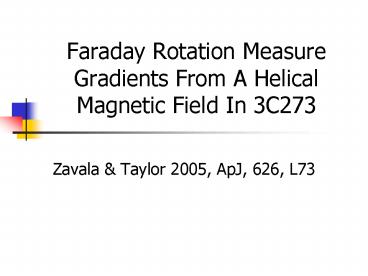Faraday Rotation Measure Gradients From A Helical Magnetic Field In 3C273 - PowerPoint PPT Presentation
1 / 13
Title:
Faraday Rotation Measure Gradients From A Helical Magnetic Field In 3C273
Description:
Faraday Rotation Measure Gradients From A Helical Magnetic Field ... This B// and B. structure appears. again. Parallel (?) to the jet. Faraday Screen in 3C273 ... – PowerPoint PPT presentation
Number of Views:65
Avg rating:3.0/5.0
Title: Faraday Rotation Measure Gradients From A Helical Magnetic Field In 3C273
1
Faraday Rotation Measure Gradients From A Helical
Magnetic Field In 3C273
- Zavala Taylor 2005, ApJ, 626, L73
2
Abstract
Using high-frequency (12-22GHz) VLBA
observations, the existence of a Faraday
rotation measure gradient of 500 rad m-2 mas-1
transverse to the jet axis is confirmed in the
quasar 3C 273. This gradient is seen in two
epochs spaced roughly 6 months apart. ? A
helical magnetic field warping around the jet?
3
Introduction (1)
The jet launching mechanism unresolved
problem Magnetic field is thought to contribute
to the collimation. Blandford (1993) urged
observers to search for Faraday rotation measure
(RM) gradients transverse to the relativistic
jet.
? Observed polarization angle
?0 Intrinsic polarization angle
4
Introduction (2)
Line of sight component minus and maximum
Plus and maximum
Asada et al. 2002
K. Asada private communication
5
Introduction (3)
The authors have reanalyzed 12-22 GHz VLBA
polarimetry observations for two epochs on 3C273
to obtain higher angular resolution transverse
to the jet axis. A scale for 3C273 1 mas
2.52pc
The observations were made on 2000 January 27
(2000.07) and 2000 August 11 (2000.61).
6
Results (1)
RM Figure 1a (2000/1/27), Figure 1b (2000/8/11)
RMgradient from 1000 to 1000
RM1800rad m-2
Main changing point the region immediately
southwest of the
Stokes I peak.
7
Results (2)
Beyond 3 mas from the Stokes I peak, the RM
distribution does not change dramatically
between the two epochs. An RM gradient
transverse to the jet is apparent.
8
Results (3)
The RM-corrected intrinsic B-vectors under the
assumption That the source is optically thin
from 12 to 22GHz.
9
Results (4)
They simply took the Faraday-corrected
E-vectors and rotated them by 90. This does
not take relativistic aberration into account
(Lyutikov et al. 2003, 2005), which could
change the orientation of the B-vectors by up
to 20.
10
Results (5)
Initially oriented roughly parallel to the
projected jet direction
Rotating to almost a north-south orientation
6 mas
This B// and B? structure appears again.
Parallel (?) to the jet.
11
Faraday Screen in 3C273
Changes of the RM near the core A region of
that size is unlikely to change over a 6 month
time interval. ?Changes in the observed RM are
caused by jet components sampling different
sight lines as they move out from the core. In
general, the Faraday screen in front of the jet
appears to be constant in time, as the RM does
not significantly change over the 6 month time
interval.
12
Evidence for a Systematic RM Gradient
RM image slices perpendicular to the jet axis for
both epoch. A transverse gradient of
approximately 500 rad m-2 mas-1 is
visible. The southern edge mostly negative.
The northern edge mostly positive. ?An ordered
helical field.
2000/8/11
2000/1/27
13
RM Distributions in Other Sources
M87 The RM data cover a relatively small area.
There is no obvious RM gradient, but the
sign changes. ?consistent with a helical
magnetic field. Gabuzda et al. (2004) report RM
gradients in four BL Lacertae sources. 3C147
(Zhang et al. 2004) An RM gradient observed at
8GHz. The quasars B1611343 and B2251158 (Zavala
Taylor 2003) No evidence of a transverse RM
gradient. At present we can say that transverse
RM gradients do exist, but these gradients are
not a universal feature.































